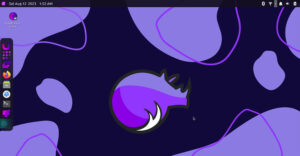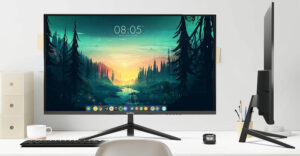Nitrux is a very new Linux distribution that has the potential to offer a more interesting desktop experience to users looking for a fresh approach to computing — but it is not there yet.
Developers describe the distro as offering an experience that is “Boldly Different.” That might be the case once they have all the non-working parts fixed. Until then, Nitrux is little more than an early work in progress that is boldly frustrating.
Nitrux first appeared in September 2018. You could download the ISO after registering with an e-mail address, and public downloads have been available since mid-2020. The Nitrux team released its major version 2.0 in February 2022, with two more point releases on Nov. 1, 2022 (2.5.0) and Dec. 3, 2022 (2.5.1).
The developer issued the newest release on Jan. 2, 2023, a short while after I finished testing the then-current version. The updated Nitrux 2.6.0 “ff” combines the latest software updates, bug fixes, performance improvements, and ready-to-use hardware support.
This distro is based on Debian’s Unstable (sid) branch with additional packages borrowed from Ubuntu LTS repositories. Its primary desktop environment is the in-house-grown NX desktop.
The desktop design is basically a KDE Plasma environment altered with “plasmoids” that let you add functionality. Essentially, this is the same functionality built into KDE. You can also use portable applications using the AppImage format.
Part of the Plasma reworking is a set of Nitrux applications built upon the bare-bones Maui desktop kit and QT. Maui is a recent new desktop project that stands for Multi-Adaptable User Interface. It enables Maui apps to run on various platforms.
Despite my penchant for innovations to expand my Linux computing experience, so far, Nitrux is boldly underwhelming for two reasons. It does not boot on lots of older gear, and when it does boot, the user experience is sorely lacking.
My impressions of the latest release left me still underwhelmed. To the developer’s credit, the newest release shows some progress toward the next level of user satisfaction. Still, as stated earlier, it is not there yet.
Troublesome Installation
Many software reviewers who are not experienced with the Linux operating system bemoan how difficult Linux is to install and use. They usually add to this broad-stroke description that Linux users must be skilled in the command line interface or CLI.
As is true with most generalizations, that assessment depicts the earlier stages from yesteryear. But every now and then, along comes a new Linux entry that presents lots of rough edges. Nitrux fits into that category. Its release numbers are beyond the development cycle’s alpha and beta training wheels stages. However, I’ve had much more pleasant hands-on experiences with many other new Linux distributions.
For instance, I maintain a variety of desktop and laptop hardware for OS testing purposes. Usually, an ISO might fail to load or install on one of these machines. But rarely do I encounter multiple failures.
The Nitrux dilemma happened on all but one computer. The ISO file would begin to load and then return to the starting screen to start over again.
Most of my gear dual boots into Windows and eclectic collections of Linux OSes. So the hardware settings are a “plain vanilla” configuration to prevent typical installation mishaps.
The release notes mention that faulty Nitrux installations are a known issue on some older hardware. So why release a new version without mitigating that problem?
After hours of tinkering, I stumbled on a workaround. Using my newest laptop, which has never presented installation issues but rarely is tasked with test bench assignments, I reconfigured the BIOS settings to disable Secure Boot and other options.
That was mostly a hit-and-miss process that finally yielded success. Oddly, duplicating those settings on my other boxes did not resolve the fail-to-boot blockage.
Guessing at Cause
Nitrux does not use systemd as its init system. Instead, it uses OpenRC, a service manager maintained by the Gentoo developers. It is dependency-based and works with the system-provided init program, normally SysVinit, according to that project’s background information.
This distro uses the Calamares installation package, which has a graphical user interface (GUI). I am just guessing here. Perhaps the terrible installation is a combination of factors, including all the under-the-hood tinkering and the patchwork of modifications that created the loading and installing issues.
But in fairness to Calamares, the mechanism that loads the ISO to boot into a live session is separate from the Calamares installer. If you do not get the live session to load, you cannot reach the installation icon on the desktop itself.
Daunting User Experience
Unfortunately, finally getting Nitrux running exposed me to more frustrations. I am used to finding my way around desktop environments. Nitrux, however, posed challenges.
Despite visual differences, most basic user functions are inherently the same from desktop to desktop. These include right-clicking to open various functions, navigating around virtual desktops, as well as clicking on icons to open, minimize, or close windows, etc.
Nitrux offered none of these conventions in most cases. Windows lacked title bars to show icons for minimize/maximize/exit functions, and right-clicking typically did not work. Even when one or two of those options were visible, they often failed to work.
For example, what should be a simple task to take screenshots was nearly impossible to do in Nitrux. The KDE Spectacle screenshot application could not see the USB drive. The interface lacked any directly obvious copy/paste process to move saved images from the pictures folder to the USB storage or elsewhere.
Other navigational nightmares involved accessing multiple virtual desktops. It was mind-boggling trying to move an open window from one desktop to another.
I am quite handy with the KDE Plasma world. But Nitrux does not function the way knowledgeable users would expect. Imagine how bewildered new users will feel.
Groping Around the NX Desktop
The NX desktop is uncluttered with a traditional-looking appearance. The performance, though, is not what I expected.
A panel sits across the top of the screen. Standard system icons to monitor audio, connections, battery, and notifications reside at the far right. Clicking on an icon opens a panel from the right edge of the screen.
Like the standard Plasma desktop, right-clicking on it opens a menu option to add widgets to the panel or the desktop. The assortment of widget options slides out from the left edge of the screen. A centered Latte dock sits at the bottom of the screen, and an applications menu button sits at the far left.

Just as in traditional Plasma mode, the icons for installed apps appear in a row-by-row display across a blurred background.

Icons for running apps show on this dock and usually can be maximized or closed with a right click. Some dock and panel configurations are available from the right-click menu.
Much of the traditional Plasma functionality and features are modified or missing. The ample configuration choices in the system panels let you construct a semblance of the Elementary OS or macOS desktops.
Bottom Line
Overall, the NX desktop suffers from an identity crisis. It is confusing to use mainly because its KDE appearance is a shell with incomplete functionality. Easy things lack any straightforward navigational tools.
I found Nitrux to be very unappealing. The developers could remove some of this bad user experience by providing a demo video or some on-screen quick-start details to provide initial orientation,
The identity crisis does not subside quickly. It takes too much time to guess and discover otherwise hidden user functions. Experienced Linux users might keep playing around with Nitrux.
I doubt newcomers will overcome the UI barriers, and I do not see this KDE retread called the NX desktop offering much for seasoned users who are used to high-end power features to get through their daily workload.
You can download Nitrux from its website.
Suggest a Review
Is there a Linux software application or distro you’d like to suggest for review? Something you love or would like to get to know?
Email your ideas to me and I’ll consider them for a future column.
And use the Reader Comments feature below to provide your input!
























































